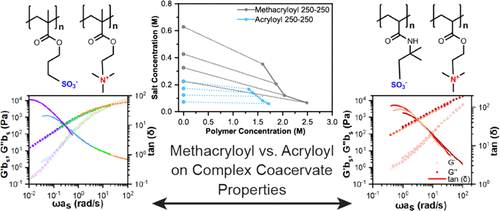当前位置:
X-MOL 学术
›
Macromolecules
›
论文详情
Our official English website, www.x-mol.net, welcomes your
feedback! (Note: you will need to create a separate account there.)
Effect of Polymer Chemistry on the Linear Viscoelasticity of Complex Coacervates
Macromolecules ( IF 5.1 ) Pub Date : 2020-09-10 , DOI: 10.1021/acs.macromol.0c00758 Yalin Liu 1 , Cristiam F. Santa Chalarca 2 , R. Nicholas Carmean 3 , Rebecca A. Olson 3 , Jason Madinya 4 , Brent S. Sumerlin 3 , Charles E. Sing 4 , Todd Emrick 2 , Sarah L. Perry 1
Macromolecules ( IF 5.1 ) Pub Date : 2020-09-10 , DOI: 10.1021/acs.macromol.0c00758 Yalin Liu 1 , Cristiam F. Santa Chalarca 2 , R. Nicholas Carmean 3 , Rebecca A. Olson 3 , Jason Madinya 4 , Brent S. Sumerlin 3 , Charles E. Sing 4 , Todd Emrick 2 , Sarah L. Perry 1
Affiliation

|
Complex coacervates can form through the electrostatic complexation of oppositely charged polymers. The material properties of the resulting coacervates can change based on the polymer chemistry and the complex interplay between electrostatic interactions and water structure, controlled by salt. We examined the effect of varying the polymer backbone chemistry using methacryloyl- and acryloyl-based complex coacervates over a range of polymer chain lengths and salt conditions. We simultaneously quantified the coacervate phase behavior and the linear viscoelasticity of the resulting coacervates to understand the interplay between polymer chain length, backbone chemistry, polymer concentration, and salt concentration. Time-salt superposition analysis was used to facilitate a broader characterization and comparison of the stress relaxation behavior between different coacervate samples. Samples with mismatched polymer chain lengths highlighted the ways in which the shortest polymer chain can dominate the resulting coacervate properties. A comparison between coacervates formed from methacryloyl vs acryloyl polymers demonstrated that the presence of a backbone methyl group affects the phase behavior, and thus the rheology in such a way that coacervates formed from methacryloyl polymers have a similar phase behavior to those of acryloyl polymers with ∼10× longer polymer chains.
中文翻译:

高分子化学对复杂凝聚层线性粘弹性的影响
可以通过带相反电荷的聚合物的静电络合形成复杂的凝聚层。所得凝聚层的材料性质可以基于聚合物化学性质以及受盐控制的静电相互作用与水结构之间的复杂相互作用而改变。我们研究了在一系列聚合物链长和盐条件下,使用基于甲基丙烯酰基和丙烯酰基的复合凝聚层来改变聚合物主链化学反应的影响。我们同时量化了凝聚层的相行为和所得凝聚层的线性粘弹性,以了解聚合物链长,骨架化学,聚合物浓度和盐浓度之间的相互作用。时间盐叠加分析用于促进更广泛的表征和不同凝聚样品之间应力松弛行为的比较。聚合物链长度不匹配的样品突出显示了最短的聚合物链可以主导所得凝聚层性能的方式。由甲基丙烯酰基聚合物和丙烯酰基聚合物形成的凝聚层之间的比较表明,主链甲基的存在会影响相行为,因此流变学使得由甲基丙烯酰基聚合物形成的凝聚层具有与具有〜的丙烯酰基聚合物类似的相行为。聚合物链长10倍。
更新日期:2020-09-22
中文翻译:

高分子化学对复杂凝聚层线性粘弹性的影响
可以通过带相反电荷的聚合物的静电络合形成复杂的凝聚层。所得凝聚层的材料性质可以基于聚合物化学性质以及受盐控制的静电相互作用与水结构之间的复杂相互作用而改变。我们研究了在一系列聚合物链长和盐条件下,使用基于甲基丙烯酰基和丙烯酰基的复合凝聚层来改变聚合物主链化学反应的影响。我们同时量化了凝聚层的相行为和所得凝聚层的线性粘弹性,以了解聚合物链长,骨架化学,聚合物浓度和盐浓度之间的相互作用。时间盐叠加分析用于促进更广泛的表征和不同凝聚样品之间应力松弛行为的比较。聚合物链长度不匹配的样品突出显示了最短的聚合物链可以主导所得凝聚层性能的方式。由甲基丙烯酰基聚合物和丙烯酰基聚合物形成的凝聚层之间的比较表明,主链甲基的存在会影响相行为,因此流变学使得由甲基丙烯酰基聚合物形成的凝聚层具有与具有〜的丙烯酰基聚合物类似的相行为。聚合物链长10倍。











































 京公网安备 11010802027423号
京公网安备 11010802027423号